The exterior cladding of a house is not only aimed at masking defects or unattractive wall material. It protects surfaces from erosive phenomena and destruction under the influence of environmental factors. A well-designed facade will be in harmony with the overall design of the building.
Basic rules for choosing material for cladding a house
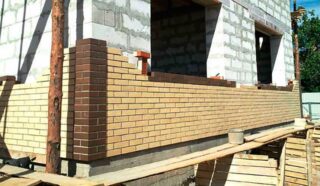
So that the air inside the rooms is not excessively humid, the vapor permeability index of each subsequent material covering the wall plane from the outside should be less than that of the previous one. The finish should allow steam to pass through better than the raw materials used to construct the building. Then the excess moisture will go out through the walls to the street.
The cladding material must have the following properties:
- resistance to rain, snow and hail, as well as temperature fluctuations;
- chemical inertness;
- color fastness, no tendency to fade or shed;
- tolerance of friction and mechanical stress.
The main criterion is the principle of decreasing vapor permeability from the inside out. If it is violated, condensate accumulates in the border area between materials with a different indicator, forming an environment conducive to rotting, the appearance of mold and mildew. In winter, the accumulated water turns into ice, which can lead to the destruction of the wall or cladding. In any case, such conditions are not conducive to long-term use of the cladding.
Features of outdoor decoration
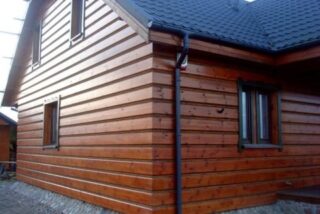
Of all the materials that can be used to clad a house, only wood products have good vapor permeability. When using other types of finishes, the task is to prevent liquid retention between the layers. The best way to do this is with a ventilated façade. The design implies the presence of a gap of 6-15 cm between the wall or layer of vapor-permeable insulation and the finishing material.
Ventilation holes are left in the cladding through which air enters the space, and at the bottom there are slots for its exit. Excess moisture is promptly removed from the inner layer, and the finish protects the facade from precipitation. This system also provides a safe home insulation. The exterior of the house can be finished with siding or other types of panels.
Another option is to fix the facing material to the wall itself, protected from the inside by a vapor barrier. Excess moisture in this case is removed by the ventilation system. Steam does not penetrate the wall material.
Requirements and recommendations for the performance of work
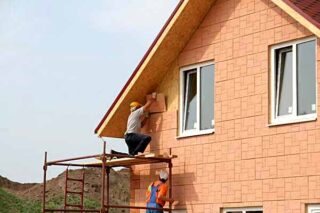
Finishing work should be done only after closing the window and door openings. An exception is allowed if the cladding is made of bricks. It should be remembered that in the first year after construction, all buildings, especially massive and heavy ones, are subject to shrinkage. Sometimes it is so strong that the integrity of the cladding is disrupted. As a result, outdoor decoration, ideally, should be dealt with only after a year after the construction of the load-bearing walls.
When choosing a material, you should correlate its features with the initial state of the building. For example, natural stone and brick have a significant mass, which creates a large load on the base. This is especially important when the homeowner plans to decorate an old building. To prevent such incidents, it is recommended to use the services of a construction engineer. He will calculate the possible additional load on the foundation.
The best materials for house cladding
Most often, homeowners prefer materials that are affordable and minimize the weight of the building. This includes paints and varnishes, various wood finishes, and special panels.
Facade plaster

Plaster can be used to cover the facade of a frame building, but its use with foam insulation creates the side effect of a "thermos" that provides a breeding ground for mold and fungal colonies. Therefore, the use of this material in such conditions is not recommended.
On the market, you can find different types of polymer-based plasters containing plasticizing additives to prevent cracking. The mix contains a step-by-step guide on how to use it. Apply the composition in several layers. The topcoat should be well leveled.
Facade paint
Such compositions can have the effect of a volumetric surface or, conversely, emphasize its smoothness. For a wooden house, the first type is usually not used: the attractive texture of the source material does not require such tweaks. "Smooth" paints are dense (for example, enamel) or transparent (varnishes).
Siding
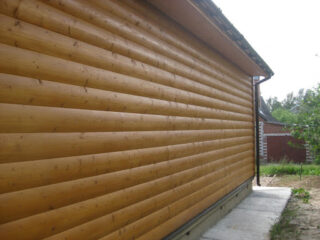
It is one of the most common cladding materials. Homeowners are attracted by the affordable price combined with the ease of installation and sufficient durability. It is produced from different types of raw materials: wood, metal (most often - aluminum), vinyl. There are options that imitate natural stone, wood pattern, timber and other expensive materials. In many ways, this type of coating is similar to clapboard. The panels are mounted on top of each other at a slope, as a result of which water can flow freely from the plane. This prevents it from penetrating the wall surface, destruction of the material and the appearance of fungus.
The panels are single or double. It is possible to decorate the dwelling with different types of siding with different textures: for example, the basement is revetted under a stone, and the main part - under a tree. The material is suitable for any type of building, be it a frame house or a building made of aerated concrete blocks.
The most common is vinyl siding. It tolerates temperature extremes, heat and frost well, and is also easy to cut, which is why it is often used to cover buildings with a large number of protrusions or a complex shape. It is better to mount it during a period when it is not cold and not too hot outside in order to avoid deformation during the cladding process. The disadvantage of vinyl siding is the tendency to fade from the action of ultraviolet radiation. On products of light shades, this is noticeably less, therefore, it is recommended to choose it for finishing a residential building.
Wood
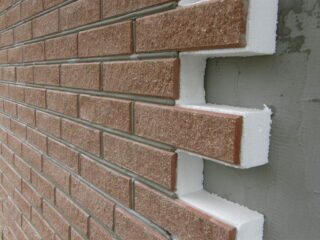
It is the most environmentally friendly material for exterior decoration of buildings. Some wood-based veneering products have a flat surface. The block house has a rounding on the front side, imitating a rounded log. Planks imitating planed timber are also used for cladding. Like a block house, they are mounted on a crate and then sanded.
Used for facade decoration and ordinary lining, as well as boards made of composite material (WPC). The latter include wood flour and polymer resins. The product does not deform during use and does not fade under the influence of the sun.
Decorative tiles
Fiber cement boards also consist of a composite material, which is a mixture of cement, wood fiber, quartz and mica inclusions. The mass is formed into sheets and moisture is removed in several stages. Sometimes it is fired. Then the sheets are covered with a decorative layer, which can be of a different nature. An inexpensive option, while retaining the freshness of the color for a long time, is an acrylic-based composition.
Panels
Thermal panels consist of a heater (it serves as a base) and a decorative layer - ceramic, clinker or made of artificial stone. They can be used to decorate different types of houses. The material has a high price.
Preparatory work
Before sheathing the house from the outside, you need to make sure that the wall surfaces do not have longitudinal or transverse distortions. If deviations are found, they are straightened with a crate or a plaster layer.
It is recommended to carry out work at an air temperature of 10-25 degrees. Too high or low value can lead to deformation of building materials during installation.
If wood cladding is used, care must be taken to protect it with flame retardant and antiseptic mixtures.
DIY home cladding technology
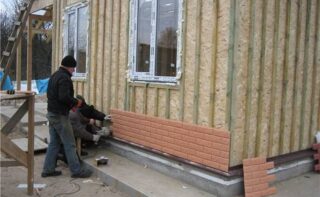
The installation method depends on the choice of finishing material.
Facade boards are often installed vertically with tongue-and-groove joints. First, the guides are mounted. They are taken out at the building level clearly in the horizontal direction. Then you can lay the insulation material. The boards are fixed to the frame in the vertical direction. You can fix them with self-tapping screws or simple nails.
You can knock the parts down with a wooden hammer to make the locks stick together. The joints of the boards are masked with cash strips.
WPC cladding is often overlapped from bottom to top in a horizontal direction. If a single plank is 10 cm wide, an overlap from each side is made at least 2-2.5 cm.








